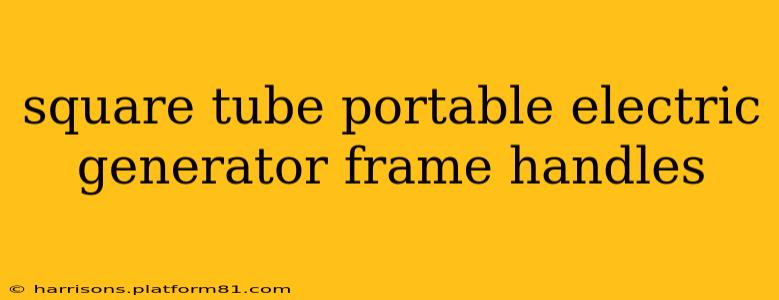Portable electric generators are invaluable during power outages or for off-grid use. However, their weight and awkward shape can make them difficult to transport. That's where a robust frame with strategically placed handles, often constructed from square tubing, comes into play. This guide will delve into the design, benefits, and considerations of using square tube for portable generator frame handles.
Why Square Tubing for Generator Frames?
Square tubing offers several advantages over other materials for constructing generator frames and handles:
-
Strength and Durability: Square tubing provides exceptional strength-to-weight ratio, crucial for supporting the weight of a generator and resisting the stresses of handling and transport. Its rigid structure prevents bending or warping, ensuring longevity.
-
Stability: The square shape contributes to increased stability compared to round tubing. This is particularly beneficial when lifting and carrying the generator, minimizing the risk of tipping or accidental dropping.
-
Versatility: Square tubing allows for easy attachment of other components like wheels, brackets, and tie-down points, increasing the frame's functionality.
-
Aesthetics: Square tubing creates a clean, modern, and professional look. It's easier to incorporate into a frame design that complements the generator's style.
What to Consider When Designing Handles?
The design of the handles is paramount to ease of use and safety. Key factors to consider include:
-
Handle Placement: Handles should be ergonomically positioned for comfortable lifting and carrying, regardless of the user's height or strength. Strategic placement minimizes strain and potential injuries.
-
Handle Size and Shape: Handles should be large enough for a firm grip but not so large as to be cumbersome. A slightly contoured shape can improve grip and reduce hand fatigue.
-
Handle Material: While the frame might be square tubing steel, consider using a more comfortable material for the actual grip, such as rubber or coated steel. This improves grip in wet or oily conditions.
-
Reinforcement: For heavier generators, additional reinforcement around the handle attachment points is recommended to prevent stress fractures over time.
How to Build a Square Tube Generator Frame with Handles?
While the specifics depend on your generator's size and weight, a well-designed frame generally involves these steps:
-
Measure your generator: Accurately measure the dimensions of your generator to determine the frame's size. Ensure sufficient clearance for ventilation.
-
Choose your materials: Select appropriate square tubing based on the generator's weight and desired strength. Consider the thickness of the tubing walls as well.
-
Cut and weld the frame: Using a metal cutting saw and welder, construct the main frame according to your design. Precise measurements are vital for a stable and secure frame.
-
Attach the handles: Weld or securely bolt the handles to the frame. Ensure they are firmly attached and won't loosen during use.
-
Finish: After welding, apply a protective coating, such as paint or powder coating, to prevent rust and corrosion.
Frequently Asked Questions (FAQs)
What size square tubing is best for a generator frame?
The ideal square tubing size depends on the generator's weight and dimensions. For lighter generators, 1-inch or 1.5-inch square tubing might suffice. Heavier generators will require thicker and larger square tubing, perhaps 2-inches or more.
What type of welding is best for a generator frame?
MIG welding is a popular choice for its versatility and ease of use. TIG welding offers superior results for those with the skill and equipment. Ensure your welds are strong and smooth to avoid sharp edges.
Can I add wheels to my generator frame?
Yes, adding wheels can significantly improve maneuverability. Choose heavy-duty wheels capable of supporting the generator's weight. Properly attaching the wheels is crucial for stability.
What are some safety precautions when building a generator frame?
Always wear appropriate safety gear, including safety glasses and gloves. Use caution when working with welding equipment. Ensure the frame is structurally sound before placing the generator on it.
By carefully considering these factors and following safe construction practices, you can build a durable and user-friendly square tube frame with handles to significantly improve the portability and safety of your portable electric generator. Remember to always prioritize safety and ergonomics when designing and building your frame.
